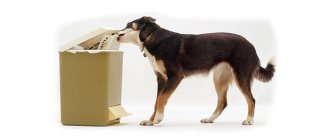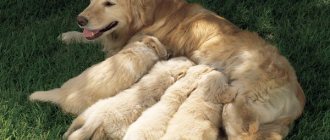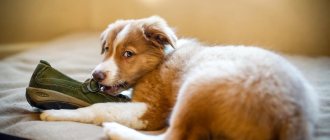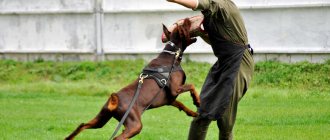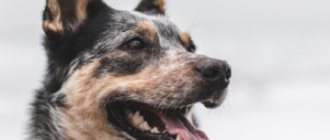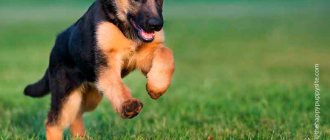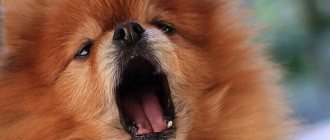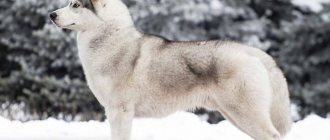Why do you need to train a puppy?
When a puppy appears in the house, he is first taught how to behave with family members and hygiene. But social behavior and obedience are the main skills that distinguish a well-mannered domestic dog. The puppy learns quickly, remembers commands and, through education and training, the dog owner establishes contact with the dog.
The sooner you start training your dog, with simple commands, the easier life will be side by side. During the training process, when the owner spends a lot of time with the pet, the dog develops a trusting relationship with the owner, provided that training brings pleasure to both.
What commands should a dog know when it grows up?
First of all, training a puppy begins with memorizing its nickname. It’s hard to even call it a team, but remembering the nickname is the beginning of learning. An adult dog living in a city must obey the rules of human society.
Every owner must teach his pet basic obedience commands. Mandatory knowledge of basic commands applies not only to large dogs; even a small terrier is obliged to carry out prohibited orders and the “come to me” command. First of all, this is the safety of your pet in the city.
- The first thing a dog needs to learn after its nickname is “no”, “no” or “fu”. Which word to pronounce is the choice of the owner. The pet does not care what word will mean the immediate cessation of any action; the owner can use absolutely any word for this - for example, “peony”, in any language, with any set of sounds and syllables. Of course, it is better for the prohibition command to be loud - such words are pronounced faster and easier to remember.
- In addition to the ban, it is necessary to teach the dog the “come to me!” command. – this is a very important element on which trust is built. A dog will not approach a person it does not trust. The command “come to me” can sometimes save the life of an animal if the dog suddenly breaks off the leash and runs onto the road.
- The "place" command is also mandatory for training. But it is necessary solely for the convenience of the owner. Every dog has a certain place in the house where it spends the most time and where it feels safe. Going to the place should not be a punishment, because she returns to the place where she will feel calm.
- The necessary commands also include the basic “sit”, “lie down”, “near”. These orders will make life easier for the dog owner, both while walking and at home.
How to become a leader
It should be understood that only one person can be the leader of a pack. It is from him that the dog receives attention, he is engaged in its upbringing. If different family members do this equally, the pet will simply get confused and will not be able to determine the leader.
The dog must be accustomed to its place in the hierarchy from the first days of its arrival in the house. It will be very difficult, and sometimes impossible, to retrain her later.
The dog should occupy the lowest level of the hierarchy - after all family members. This does not humiliate her as a canine person, but it allows all family members to comfortably coexist with the pet.
On the way to raising a pet, many mistakes are made from the first days of its life in the house. If you have not yet committed them, read the basic rules to prevent them from happening in the future.
Communication with a puppy
In dog packs, puppies are not particularly coddled. No attention is paid to them at all until they themselves ask for it. Everything is changing in our house. The puppy is picked up, kissed, stroked, and put to sleep in his bed. His worldview is formed in such a way that he is the main one in the house, so everyone rushes around with him. In fact, the puppy should immediately know its place, and receive exactly as much attention as is necessary for its socialization. And of course, he should have his own place to eat and sleep.
A dog sleeping in its owner's bed considers itself equal or superior to him in position in the pack.
Feeding
When the leader of the pack eats, the rest of its members do not dare look at him. When he is satisfied and leaves, they will get the leftovers. In our country, the dog is often fed first in the same kitchen where the whole family eats.
The best solution would be to separate the place where the pet and the family eat (for example, in an apartment, the dog can be given a place in the hallway or the dog can be left in the kitchen, and the family can eat in the dining room). While eating, the dog should not be near the table (you can, for example, close the door). This, by the way, will eliminate such a problem as begging, which is equally bad for assessing one’s place in the hierarchy (it greatly overestimates it) and for the pet’s health (food from the table is not at all suitable for dogs).
Video: becoming a leader through feeding
Toys
A dog should have no more than 2-3 toys at a time. And you, the leader and leader, manage them. This means that after a certain time you can replace them with others, and also have the right to take any toy from the dog at any time (with return), and it should not show aggression in response (any manifestation of it, for example, a roar, should be stopped in a stern tone). Usually this concept is formed during joint games, which at first should only be carried out by the most important owner.
Right of the first step
In a pack, the leader comes first because he is responsible for safety. The pack members follow him. Now remember who comes out of the door first for a walk and comes back into the house? It should only be the owner, always and everywhere. Whatever it is more convenient for you to do otherwise, adapt to this rule. This is an important aspect of the leadership position; the dog should not get a head start on it.
Who goes first is in charge
Other recommendations
Always give commands to your dog in a calm and moderately quiet tone. Never become rude; a stern reprimand is quite effective. Perhaps if you hit your pet, he will quickly do what you need here and now, but you will already lose some respect for yourself. In the long run, only those relationships that are built on friendliness and care benefit. The pet will definitely respond to them with devotion and a desire to please.
Video: how to become a leader for a dog
Techniques and methods for teaching commands
The most popular types of training are positive and negative reinforcement and imitation. These methods are related. It is extremely difficult to achieve good results using only one method.
- The negative reinforcement method involves the use of parfos, nooses, and electric shock collars (ESC). These devices are used either through a remote control - like an EShO, or using different jerking forces. Soft ammunition can also be used on a dog and this method is preferable, it is less traumatic and more humane.
In addition, ignoring a dog is also a method of negative reinforcement: nothing in the world is more important to a dog than the attention of its owner.
The essence of negative reinforcement is to stop an undesirable action or correct an undesirable behavior.
- Positive reinforcement, on the other hand, encourages correct behavior. Using this method, they use treats, games, and praise from the owner. In the first stages of education, it is better to combine several conditions - for example, praise and treats are required, or praise and play. Praising your pet for correct behavior is a must throughout the dog’s life. There is no greater pleasure for a pet than to please its owner. Over time, praise will become an independent type of reinforcement and neither treats nor play will be required.
- Imitation is also a fairly effective training method. It consists in the fact that a dog copies the behavior of another animal and transfers some behavior to itself. During the period of socialization, a young dog begins to associate itself with a certain creature, depending on who surrounds it. If a dog lives with a cat from the first month of life, then there is a high probability that it will identify itself with the cat, if with dogs, then it considers itself to be part of the world of dogs. Therefore, it is very important not to take the puppy away from its mother and breeders too early, so that the dog learns to correctly identify itself.
All of the above techniques are used comprehensively. It is impossible to fully train a dog using only one method. The imitation method works well, but not every person can afford to keep several animals. Then you can invite friends with an adult, well-mannered dog to the lesson.
How to teach your dog commands: list of commands | how to teach, training, video
Some owners are sure that the dog does not need to be taught commands if it does not take part in competitions and exhibitions. But this is a fundamentally wrong position.
A well-mannered and obedient pet is not only a reason to be proud, but also an opportunity not to experience behavior problems during a walk or in other situations.
This is true not only for representatives of large or fighting breeds, but also for decorative dogs, which can also cause a lot of trouble to the owner, surrounding people and animals.
What commands can be taught
This is rather a rhetorical question, since dogs are highly trainable and, with due attention and patience, can master any skill they want. Some people want their pet to fetch items, while others want them to guard their home.
The main thing worth highlighting is that he must respond to his nickname, hear and obey his owner when he receives an instruction or sees a warning gesture. There cannot be a single list for non-service breeds, so it all depends on the owner and personal preferences.
Nevertheless, there is a list of basic commands that develop the animal’s agility, obedience and intelligence.
"To me"
One of the basic commands that must be practiced until it is executed perfectly, since in some cases it can save the pet’s life.
At first it is pronounced when the dog is already running towards the owner, and later - using attractive objects (treats, toys).
The order is given in a calm voice from a short distance, and when the student has mastered it a little, you need to increase the distance and, ideally, achieve fulfillment even when the owner is out of sight (for example, in another room).
You should not use the command “Come to me” before doing things that are unpleasant for the animal (trimming claws, scolding for something, etc.).
First stage: training in basic commands
"Ugh"
The prohibitive command is the most important stage of training. It is one of the main skills, after the nickname.
Training is based on the carrot and stick principle . A loud exclamation of “fu” is accompanied by negative reinforcement - a jerk with a leash, a slap on the rump with a newspaper. Immediately after the cessation of the unwanted action, use positive reinforcement (praise, treat, toy).
It’s better to start practicing the skill at home, teach him to spit out toys, as if exchanging a toy for food. You can simulate throwing food on the street. While feeding the puppy by hand while walking, you “accidentally” drop a piece. As soon as the pet tries to pick up the food, you need to stop it by holding the dog and commanding “fu”. Immediately give another piece of treat from your hand. Systematic repetition of this exercise shows positive results in practice. In addition, you can teach your dog to eat from his bowl only after the command “maybe”. This will help the puppy understand that all food belongs to the owner, and it cannot be taken until the command is given.
The pet quickly grasps the connection between behavior, prohibition of action, execution of a command and receiving a treat. And also quickly learn to execute a command.
When training any team, the main thing is consistency. You cannot allow it once, then prohibit it and then allow it again. Only a constant, identical reaction to the same action will teach your pet to quickly follow orders.
"Place"
A dog should have a place in the house. In which she feels comfortable - a cozy corner without drafts. It is advisable to have a view of the area and the front door from the spot; this will make the pet feel calmer. It is better if there is a wall on one side of the bedding - a protected rear will add confidence to the animal.
You cannot punish a dog for misbehavior while it is on its bedding. The dog's place should be associated only with positive emotions; if the puppy behaved badly and hid on the bedding from punishment, all punitive measures must be stopped immediately.
In order for the dog to quickly remember the command “place” and have pleasant associations, you need to throw a piece of treat on the bedding and say the command. Naturally, the puppy will run for food, while he is eating, you need to approach him, once again reinforcing him with a treat and praise “well done, place.” To consolidate the skill, the exercise must be repeated daily, several times a day.
"To me!"
Another important command is “to me.” Full management of an animal in an urban area that cannot run up to the owner’s call is impossible. When training the “come to me” order, it is strictly forbidden to use negative reinforcement, otherwise the training will not only be delayed - the pet will completely refuse to approach the owner. You need to start training on a leash, only after 10 approaches out of 10 can you start letting the dog go.
The training proceeds as follows:
- When the dog is distracted and moves away from the owner or sniffs at someone’s mark, you need to pronounce the name loudly or attract the pet’s attention in another way (whistle, clapping your hands).
- As soon as the puppy’s attention is attracted, you need to clearly say “Come!” and start moving away from the dog, for kids this becomes a fun game of catch. Or show your pet a treat; if he is hungry, he will definitely run for the treat.
- While the puppy is running, you must definitely praise and encourage him in a cheerful voice.
- When the puppy runs up, immediately give him food or start a short game, without ceasing to praise and stroke him.
This command is learned very quickly - the dog enjoys not only receiving rewards, but also the admiration of the owner.
"Give me your paw"
When training, methods of positive and negative reinforcement are used. A treat is taken in your hand - what the dog loves most. The treat is clenched in the fist. With your hand outstretched, you need to give the command “Come to me”, repeat it periodically.
The puppy will try to get the treat in different ways; it will try to bite, lick, and poke its nose. Misbehavior should be responded to with a prohibition order (negative reinforcement). But as soon as the baby touches his hand with his paw, at the same moment open his palm and give the food, praising the puppy.
Repeat 3 – 4 times, periodically changing hands so that the dog follows the order from either hand.
Full article on this topic: “Teaching the command “Give me your paw!”: training methods from a dog handler.”
"Sit"
You need to take a piece of treat in your fist and bring it to the dog’s nose . Slowly move the hand with the piece from the muzzle up and slightly back so that the pet raises its head while chasing the food. At this moment, you need to say the command “sit” and raise the treat a little higher. Trying to reach, the dog will sit instinctively. If the dog is overexcited and starts jumping, demanding to give food, you need to fix the head by the collar and put a little pressure on the croup. After completing the order, it is necessary to reward and give away the “yummy”.
"Lie"
When the dog knows the “Sit” command, sit the puppy in front of you, showing the treat in your hand.
Say the command “Lie down” and move the hand with the treat clamped in it down in front of the dog’s nose, towards the front paws. The dog will instinctively stretch and lie down. As soon as the command is completed, repeat “Lie down”, immediately give the treat and praise.
"Voice"
When a dog sees any irritant - be it a cat, another dog, some object and begins to bark, you need to command “Voice” and, while the dog is barking, praise and encourage . The puppy will not immediately understand why in some cases he is scolded for barking, and in other cases he is encouraged. The vocal command should be given every time the dog barks so that the action is reinforced. If the dog starts barking without the “Voice” command, you should ignore it, completely ignoring this behavior.
Practicing this command will allow you to correct unwanted behavior.
"Near"
The “near” command is the only repeating order, which must be spoken several times while moving. The main position is that the pet sits at the handler’s left leg. The beginning of the movement corresponds to the command. After pronouncing the order, you need to start moving, while at the same time not losing the puppy’s attention with the help of a toy or treat. In the first stages of training, you need to praise your pet every few steps. After successfully passing 2 - 3 meters, let them go for a walk.
"Aport"
This command is most easily practiced with young dogs during play. When throwing any objects (a stick, a ball or your favorite soft toy), command “Fetch.” Reinforcement of the team in this case is receiving the treasured toy.
Fetching a toy can be trained using the order “Come to me” immediately after the dog has picked up the fetch object.
General training course
The general training course is based on systematic training with the dog.
The skills and abilities developed during the general course form the basis for the formation of conditioned reflexes in an animal.
By the way, one of the first skills that a puppy is taught is the ability to go to the toilet only outside. During the training process, it is necessary to practice commands with gestures for dogs, and not just with your voice.
General skills and abilities include:
- response to nickname;
- habit of wearing a collar, leash, harness;
- approach to the trainer;
- walking nearby;
- the dog’s habit of lying down, sitting, standing, crawling;
- the ability to raise a voice, stop certain actions, and overcome certain obstacles;
- refusal of other people's food;
- tolerance to noise stimuli.
General principles of training
To successfully train a pet, systematic training is necessary. The duration of the lesson should not exceed 2 hours. Commands for dogs: the list of techniques practiced in the lesson depends on the dog’s level of training; for example, a Labrador puppy begins to be trained from the first months.
Gradually, the number of techniques should be increased in accordance with the success of the formation of conditioned reflexes in the dog.
New techniques are practiced in the first part of the lesson. After each command, it is necessary to organize a three-minute break for the pet.
Rules for successfully training a puppy:
- Techniques performed correctly should be reinforced with praise and encouragement.
- It is better to voice the instruction once, accompanied by a gesture.
- Maintaining consistency in orders and gestures.
- The first lessons should be conducted in a familiar environment, then you can change the location of the lessons.
- Both the trainer and the dog are in a good mood.
- It is better to end the lesson with the team that the puppy does better than the rest.
List of commands for dogs and how to teach them
It is advisable to start training with the main and most necessary orders, such as “Come to me!” and “Ugh!”
These commands for dog training allow you to quickly call the puppy to you whenever necessary and stop unwanted actions.
The indication “Near!” allows you to be near the owner under different circumstances.
The order “Get in place!” forces the dog to go to the enclosure or to his mat.
The instruction “Sit!” usually learned together with the command “Near!”
Permissive instruction “Go for a walk!” allows the dog to walk freely.
Then you can proceed to the instructions “Lie down!”, “Stand!”, “Aport!”
The main commands for dogs: a list and how to teach them, we will consider further.
- "To me!".
- "Ugh!".
- "Near!".
- "Sit!".
- "Lie!".
- "Stand!".
- "Give!".
- “Aport!”
- "Walk!".
- "Place!".
- "Fas!"
"To me!"
The team is considered the main one. Its precise execution makes it possible to guide and control the dog. To begin with, the pet must be on a leash and have some freedom. Next, the instruction “Come to me!” is given. and a treat is shown, it is given to the animal as gratitude.
If the puppy is disobedient, you need to pull it towards you with a jerky leash, and then reward it with a treat. The intonation should be calm and not irritating.
With the order “Come to me!” a gesture is made with the right hand to the thigh. Further, it can only be given by gesture.
"Ugh!"
This is another basic command. It requires clear and strict intonation. When the puppy tries to pick up a prohibited object or runs after someone, you need to stop her with a leash and order “Fu!” You can practice this skill yourself, at home.
"Near!"
It is advisable to study this skill after the pet has walked and is not distracted by external factors. The dog must be placed on a short leash and clearly ordered “Near!”
You need to repeat this technique when the dog moves away from your leg, while sharply pulling the leash towards you. To reinforce the skill, reward your pet. Next, this command must be repeated in the absence of a leash. This skill is required for serious breeds of the Cane Corso or Basenji level.
"Sit!"
This skill is learned with the help of a short leash. The puppy should sniff the tasty treat, then raise it above his head and clearly voice the instructions. After successfully completing the technique, it is recommended to reward your pet.
This operation must be repeated several times to secure it.
"Lie!"
The list of commands for dogs with gestures needs to be mastered in order. You need to start learning this technique after successfully completing the order “Sit!” The lying position is achieved from a sitting position by pressing on the withers of the animal and pulling the leash down without sharpness.
The gesture for this order is to sharply lower the right hand down.
"Stand!"
To learn this order, the starting position is lying or sitting on the left side of the trainer. You need to lift the leash or collar, and with your left hand – the dog’s stomach and say the instructions.
The command is characterized by a gesture of the right straight arm, which must be raised up from the hip.
"Give!"
“Aport!”
The “Fetch” command is best practiced in gameplay with a ball, toy or other familiar object.
First you need to seat the student with the order “Sit!”
Next, you need to interest the puppy in the toy, and when he tries to snatch it or take it away, you need to throw it away and say “Fetch!” At the same time, gesture with your hand to the side.
After the dog takes the item, you need to thank it with a treat. Further, the technique can be complicated by training the pet to fetch a thrown object.
"Walk!"
This command is not difficult for a dog. The order “Walk!” is pronounced, and the direction of movement is indicated with a gesture.
"Place!"
The list of dog commands includes telling your pet to take his place. First, you need to mark the place with an object familiar to your pet, but not with the one used to practice the “Fetch” command.
The dog needs to be ordered to “Lie down!”, place this object in front of it and order “Place!” Next, move to an accessible distance, call the student to you and command “Place!”
The pet should go to a place to lie next to this object.
The command corresponds to the gesture of pointing with the right hand, palm down from the waist.
"Fas!"
To the indication “Fas!” You should start only after mastering all the previous commands. It is recommended that this command be taught in the presence of an instructor. After receiving the command, the dog must attack the object. The student must be at least 6-10 months old.
Teach the command “Fast!” Only mentally healthy and balanced individuals are allowed.
In the course of constant systematic training, the dog gradually begins to unquestioningly obey the owner, while at the same time enjoying communication with the person. Joint lessons improve psychological contact and teach you to more sensitively perceive the intonation and mood of the owner.
Additionally, check out the video about training dogs for each of the main commands:
Stage two: learning unusual commands
Every owner wants to see his dog special, wants to teach him some unusual tricks. The desire to stand out is completely normal, because a well-mannered dog is the pride of the owner and the envy of others.
"Kiss"
To teach this command, contact with the owner must be excellent. This simple trick is based solely on trust between the pet and the owner.
To practice the skill, you need to sit the dog in front of you, say the command “Kiss” and, with a treat clamped in your teeth, lean towards the dog. Correct execution of the order looks like this: the dog places its front paws on its chest and licks its lips. Reinforcing the skill in this case is by encouraging the owner and receiving a treat.
"Serve"
To train, you need to sit your pet in front of you . Hold the treat in your hand in front of your pet’s nose, up and slightly back. The dog will try to reach the food and as soon as it lifts its front paws off the surface, command “Serve” and give the reward.
Another training option could be mechanical stimulation. When the dog is sitting, you need to take it by the front legs with your hands and lift it to the level of the dog's chest, at the same time a command is given. In the correct position, a treat is given, then you can release the dog.
"Spin"
To teach your dog the funny “spin” trick, you need to take a treat in your right hand and, using pointing, force the pet to make a 360-degree turn around itself . Immediately after this, give the reward. Only after several repetitions can you link the dog’s actions to the command, when the animal begins to understand what they want from him.
"Bow"
Executing the command is similar to the order “Lie down” . The dog must stand calmly in front of the owner. After giving the command “Bow,” move the hand with the food down towards the front paws. When a dog stubbornly lowers its croup in an attempt to lie down, you need to support the lower part of the body with your hand.
"Snake"
First, the “Next” command is executed, the dog stands on the left side of the person. The “Snake” command is practiced like this: there should be food in your hand, slowly lead it in front of the dog’s nose, passing your hand between the legs. The movements should be slow so that the dog understands what is required of it.
"Back"
It is not easy to train a dog to carry out this order - in nature, a dog does not walk backwards, it turns its body around.
Starting position – the dog stands in front of the owner. The command “back” is given and the person begins to move towards the dog. Instinctively, the dog will begin to back away a little so that the owner does not step on his paws. Even if the dog took just one step, this is already worthy of praise. The number of steps must be added gradually during training.
"Ring Jump"
The ring must be large enough so that the dog can easily pass through it. First, you need to place the ring on the floor and use a treat to show the direction of movement through the ring. When the dog passes, praise and give a treat. As you practice the skill, gradually raise the ring higher.
Basic rules for training a puppy
As soon as the puppy got comfortable in the new place and began to get used to its owner. When he understood his name and began to respond, you need to start raising the baby. The optimal period for starting training is the fourth or fifth month of his life.
Many owners of four-legged animals resort to the services of professionals (canine trainers). But if you have decided to train your little dog yourself, you should at least take advantage of the tips and tricks for training dogs from experienced people.
• Every time you walk, first for a few minutes, then longer, you need to conduct exercises;
• You can’t start training a puppy when he doesn’t feel well, is unhappy or hungry. He must be morally predisposed to spending time and communicating with the owner;
• Start learning the commands one by one, starting the second only after the baby begins to clearly understand the first. Training should be carried out in one permanent place, when the first command has been learned and consolidated, it is necessary to change the place for walking and repeat the learned material;
• In order for the puppy to prepare for the task, you must first say his name, then give the command. He will subconsciously begin to understand that something is required of him.
• The dog must understand the owner’s tone well, so the command word should be pronounced clearly and in a serious voice. As soon as the dog does everything correctly, you must praise him more gently. Encouraging the puppy to give his favorite treat;
• It is unacceptable to shout or hit the baby. You need to patiently repeat the same command over and over again until the pet remembers it. After all, even service dog breeds require more than one day to train one command.
Advice from a specialist
A list of tips for raising a puppy from a dog handler:
- Young animals should not be overly taxed; exercise should be frequent, but not prolonged.
- The total time for training is from 60 to 90 minutes a day, with breaks.
- The execution of commands must be consistent; you cannot give your pet more tasks than he can complete.
- All orders are given once; if the puppy refuses to comply, he is brought to the desired position mechanically.
- Good motivation is the key to successful training.
How to teach a puppy to sit on command
The “sit” command is not the most important, but necessary. When performing it, the four-legged dog must sit in one place and not move when required.
During training, you need to get up from the animal's back, take the leash in your hands, say the dog's name and then a command. At the same time, pull the harness slightly back and down, placing a slight emphasis on the croup.
During this process, the puppy should sit down on its hind legs and sit down. Of course, the dog will immediately want to get up, it’s worth repeating the lesson again and again. When the animal sits down and does not try to jump up, you need to praise it and treat it with a treat.
Command "give"
It is similar to the “fetch” command; the dog must understand that he needs to bring and give any object to the owner. “Aport” is usually used for large and service dogs. You can teach the word “give” to a small lap dog.
It is necessary to indicate with a hand gesture the object that the dog needs to bring. When your pet learns to do this, be sure to reward him. Carry out the lesson no more than once and give the animal a rest, otherwise he will lose the desire to continue learning.
Useful links:
How to teach a puppy to walk next to you
This is a necessary command for the animal; during walks in public places, an adult dog must behave in a civilized and well-mannered manner. Walk next to the owner, be in sight, and not run back and forth tugging on the leash.
Start training when the dog goes for a walk. During movement, the dog is moved to the right side of its owner. The command "near" should make it clear that he needs to walk at the same pace with the owner's right foot.
Keep the leash taut at a distance of 30 cm from the person. At first, the baby will get confused between his legs, so you need to regularly pull him towards you and return him to his place.
When the dog begins to understand what is required of him, it’s time to start jogging or turn right or left. The puppy must always be near the right leg at the same distance.
